MB&F HM11 Architect: Revisiting the Future
Ideas of what the future could be changed dramatically following World War II. Before the war, all visions of the future seemed to be extensions of the current day, with people from 1900 making depictions of the year 2000 looking as if the Victorians made flying machines and wired picture-phones.
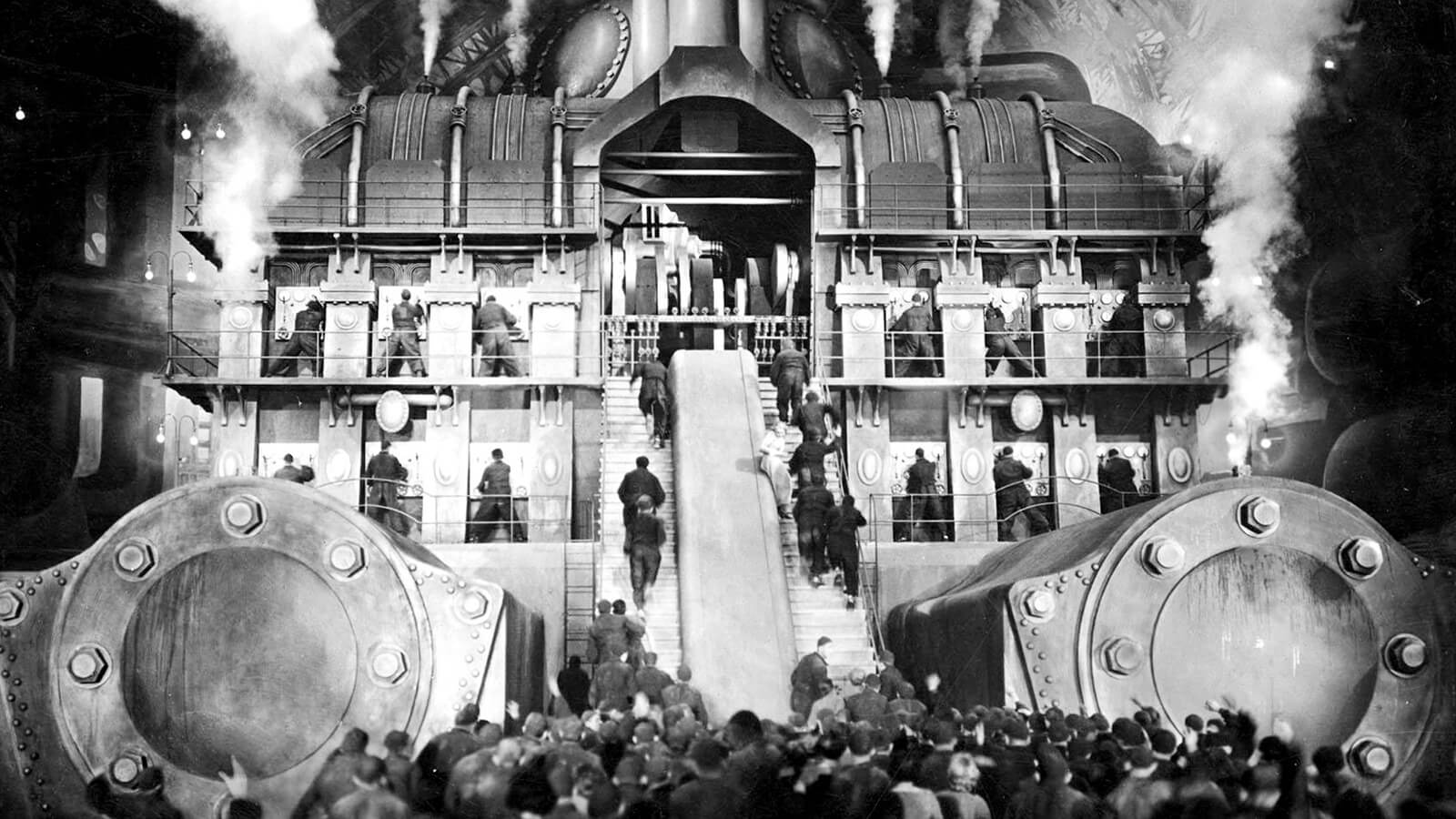
Fritz Lang Metropolis film (1927)
Even Fritz Lang’s Metropolis from 1927 was a dystopic Art Deco vision of the future that would have still felt contemporary to its time. The end goals of the technological predictions didn’t necessarily change after WWII, but the idea of what it could look like dramatically did. There was a singular reason: the atom.
Post-1945 is often described as the atomic age, when the entire world knew we could harness the immense power of the atom, and the future should be filled with limitless energy and technological abundance.
Of course, this didn’t necessarily come to pass, but psychological and artistic ideas of what could be encountered a major shift, and aesthetics of the future expanded to fill every corner of the imagination.
Shapes, colors, materials, and the source of power for machines were now entirely up for grabs and the result was a plethora of design movements that gave us a magnificent view of different worlds.
One of the more popular futuristic design movements was space age design, centered around round or curved shapes, bright colors, clean white surfaces, and the noticeable shift to world in which the cube/rectangle was not the foundation of all aesthetics.
While it didn’t necessarily find its way into every home or every public space, it did have a massive impact on what the world of the future could be.
Gone were the days of overly ornate buildings and design where texture was almost fractalized and required complex decoration, this was replaced by smooth surfaces or textures created by materials or the simple contrast between patterns and the lack thereof.

Atomium in Brussels (photo courtesy Marek Śliwecki/Wikipedia)
Furniture, vehicles, gadgets, and buildings all received the treatment of space age-ification, even resulting in spaceship homes and the very famous Atomium in Brussels, Belgium. A quick Google search of “space age design” should give you an immediate understanding of the general aesthetic vibes.
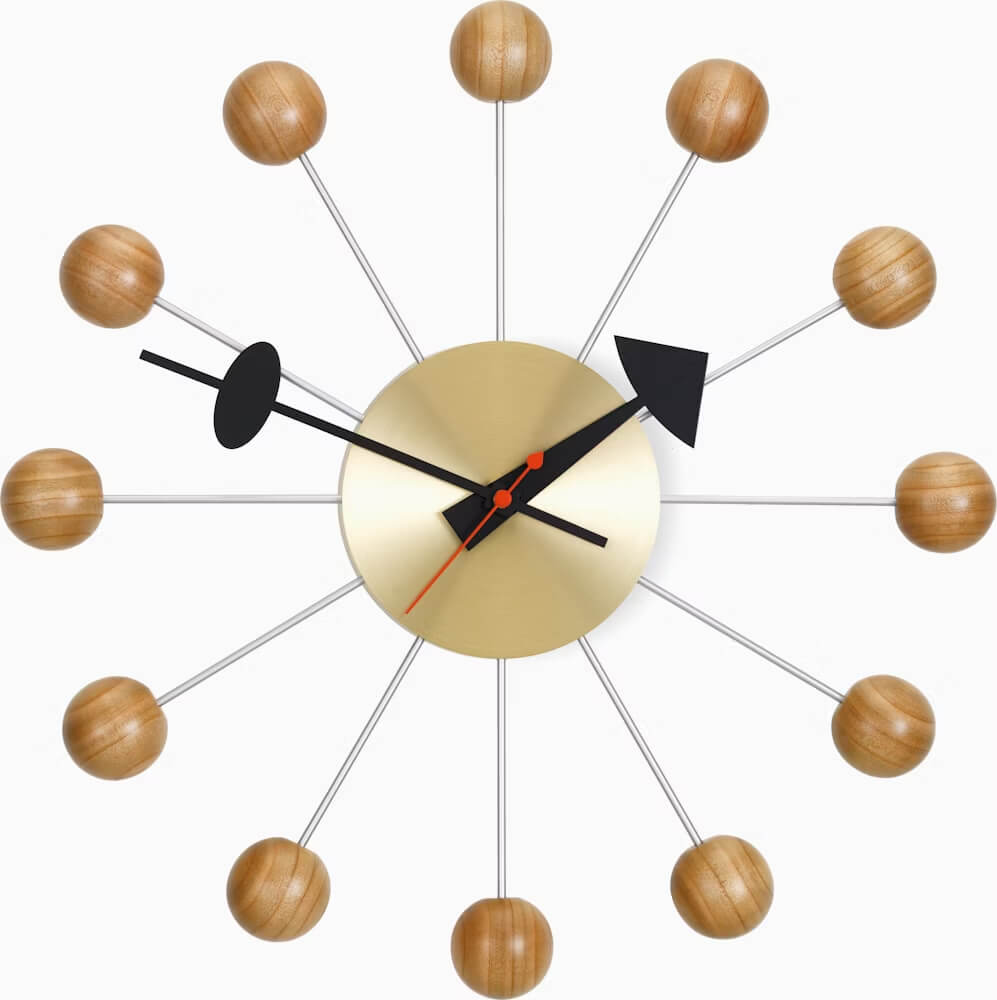
Herman Miller Ball Clock
Something that many may have direct experience with that came from this design ideology is the Herman Miller Ball Clock, designed by Irving Harper and first released in 1948, just three years after the atomic age began with the end of WWII.
The clock was originally produced through 1969, showing how long this design ideology lasted until the United States landed on the moon and global priorities shifted.
Such a defining aesthetic is bound to leave an impression on a lot of creative people, showcased by how often new designs will be inspired by this era in design and technology.
For anyone in the watch industry, you already know that this is where we return to Max Büsser and MB&F. This man and his brand are quite obviously rooted in the design aesthetics of the 60’s and 70’s, and he says as much whenever a new piece comes out.
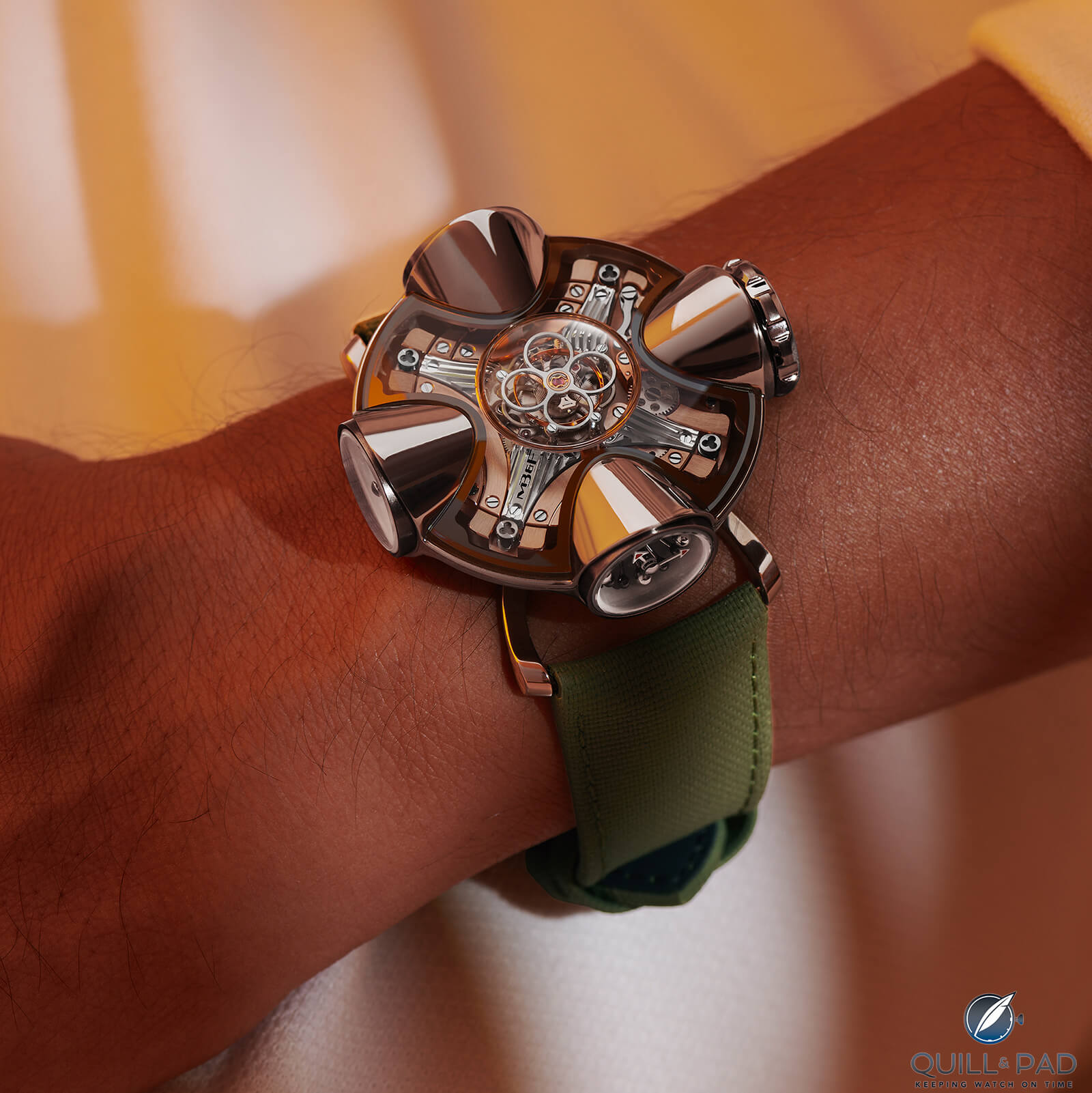
MB&F HM11 Architect in red gold on the wrist (photo courtesy Eric Rossier/MB&F)
The latest piece of horological awesomeness that comes straight from space age aesthetics is the HM11 Architect, a literal spaceship home for the wrist, packed with goodies that you might be surprised to find.
MB&F HM11 Architect
So how does a spaceship become a home and then a watch? Like most creative projects, it begins with an observation, in this case of one such futuristic house, and fascination that leads to a question, this one from Max himself, “What if that house was a watch?” Pretty normal thought to have, if you are Büsser.
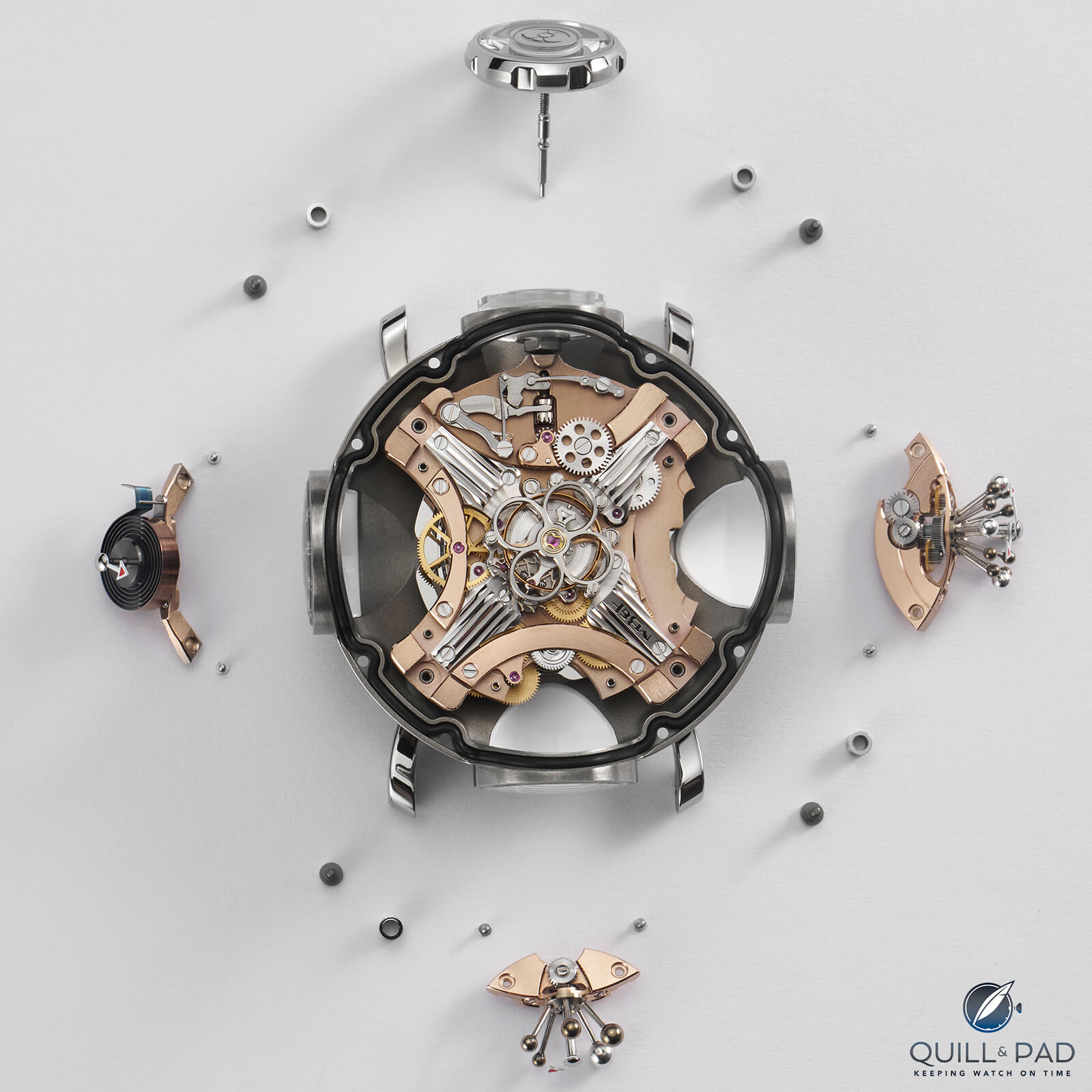
Rotating movement of the MB&F HM11 Architect
The concept took shape into a machine that incorporated classic MB&F design elements and the idea of functions being separated by rooms.
These rooms would be radially situated around a central engine, the flying tourbillon, and display the time, power reserve, and in a nod to the home concept, the temperature.
That’s only three, leaving the fourth room to house the crown, used for time setting only, as the winding mechanism has become a major feature of the HM11.
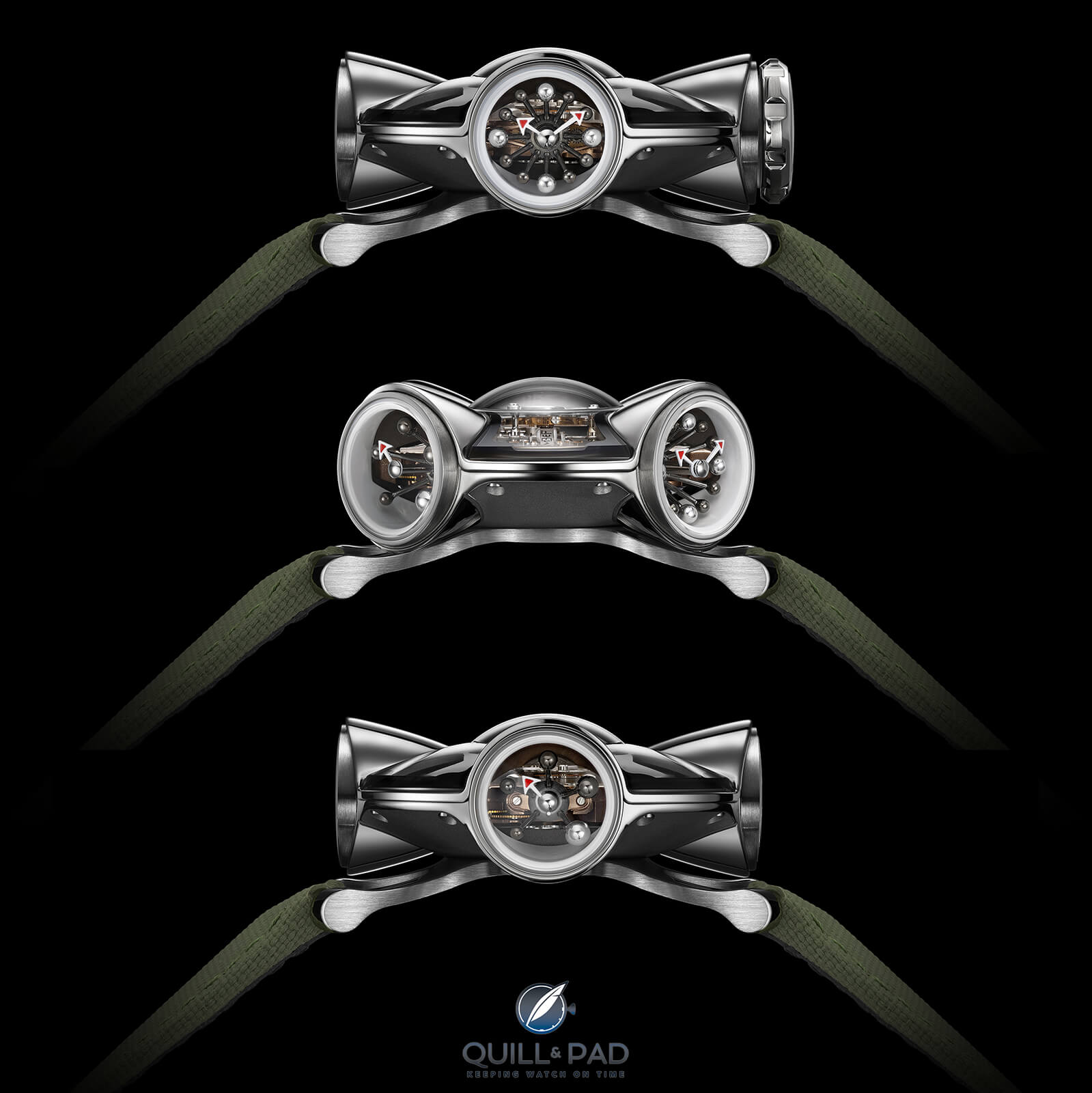
Rotating views of the MB&F HM11 Architect
Since spaceships, or at least classic sci-fi flying saucers are often depicted as rotating, it makes perfect sense that so would the entire case of the HM11 Architect.
The body is rotated clockwise to wind the mainspring, taking only ten rotations for the full 96-hour power reserve.
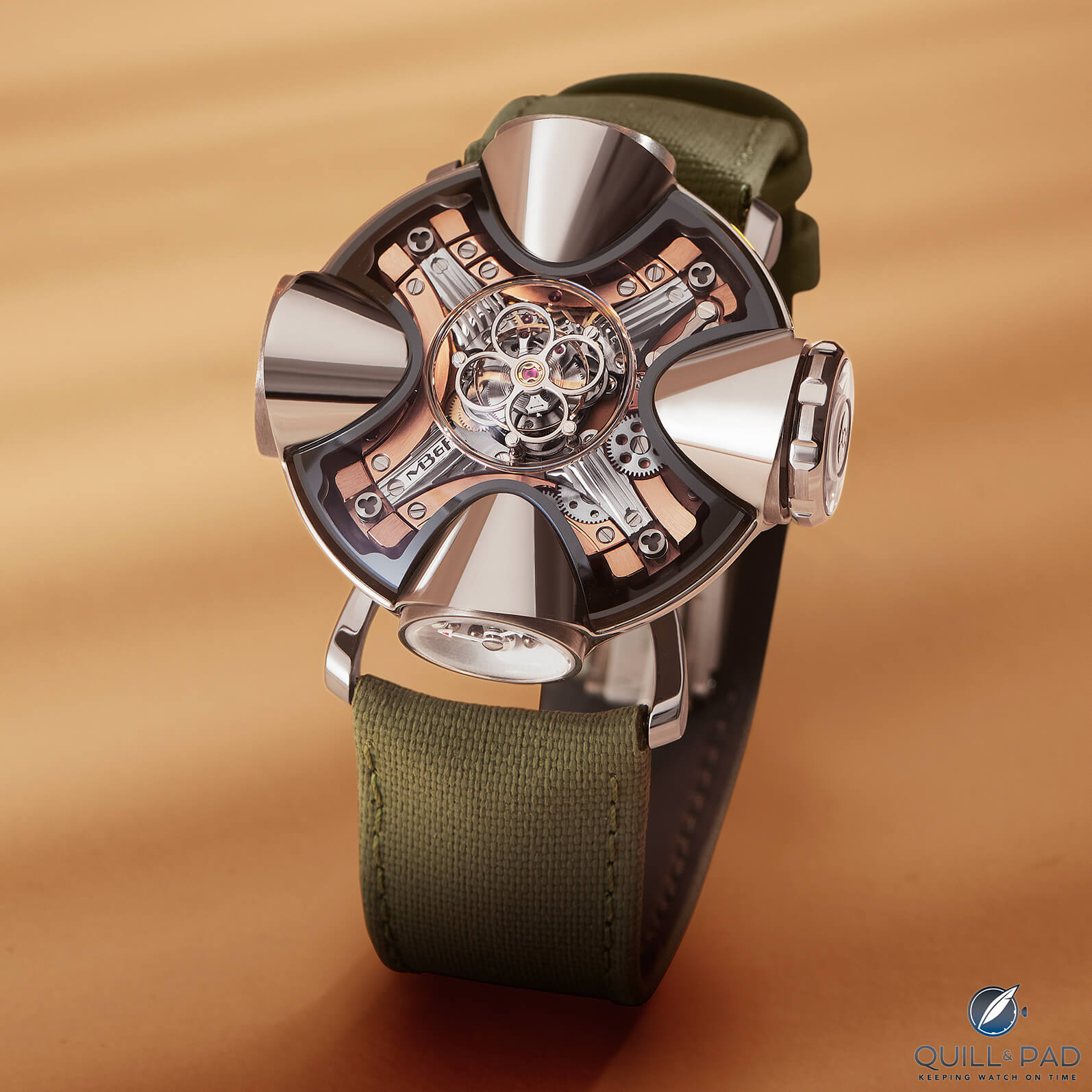
MB&F HM11 Architect in red gold (photo courtesy Eric Rossier/MB&F)
To ensure interest, the upper hull of the HM11, or perhaps the roof (to continue the house analogy), is a giant sapphire dome that exposes the entire inner workings of the HM11 caliber.
The rooms are each covered by polished titanium arches that taper back into the center of the case, mirrored on the bottom as well, protruding from the disc shaped main case like pods.
This aesthetic is a fantastic amalgamation of MB&F design and that of classic space-age architecture.
Architectural inspiration
One of the primary inspirations for the HM11 is the architectural style of Antti Lovag, Hungarian architect and designer who described himself not as an architect but a habitologist. He said that “Architecture does not interest me. It is humanity, the human space that interests me.”
As a result, he had an aversion to straight lines and anything rectangular, seeing the circle and sphere as much more natural, hence his fame for creating “bubble” architecture.

Matti Suuronen Futuro homes in Taiwan (photo courtesy Outlookxp/Wikipedia)
But Lovag’s designs don’t get you entirely to the HM11, not unless you combine them with the work of Matti Suuronen, a Finnish architect that was behind the literal spaceship house, the Futuro.
On top of these two, there are a handful of other designers that created things well within this wheelhouse, including Claude Hausermann-Costy and his Unal House, Graham Birchall’s Bubble House, Charles Haertling’s Brenton House, and we can’t ignore the influence of the futuristic Theme Building (nicknamed Googie) at LAX, or the plethora of Space Needle style buildings.
Inspiration is a fickle thing, the wide world of design allows for elements of a great many things to work their way into the final shape. The HM11 feels eerily reminiscent of so many things yet is incredibly unique at the same time.
This is largely because the space age design aesthetic is so well understood yet loosely defined that it is clear when something like the HM11 Architect is designed along the same lines.
Design driven engineering
Going this route does offer a unique design, but the mechanical constraints increase dramatically when shape, layout, and function are the driving forces.
Let’s start with the crown and work our way around the little spaceship house on the wrist. One of the rooms of the HM11 houses the time-setting crown, which normally could be fairly standard, but MB&F is anything but standard.
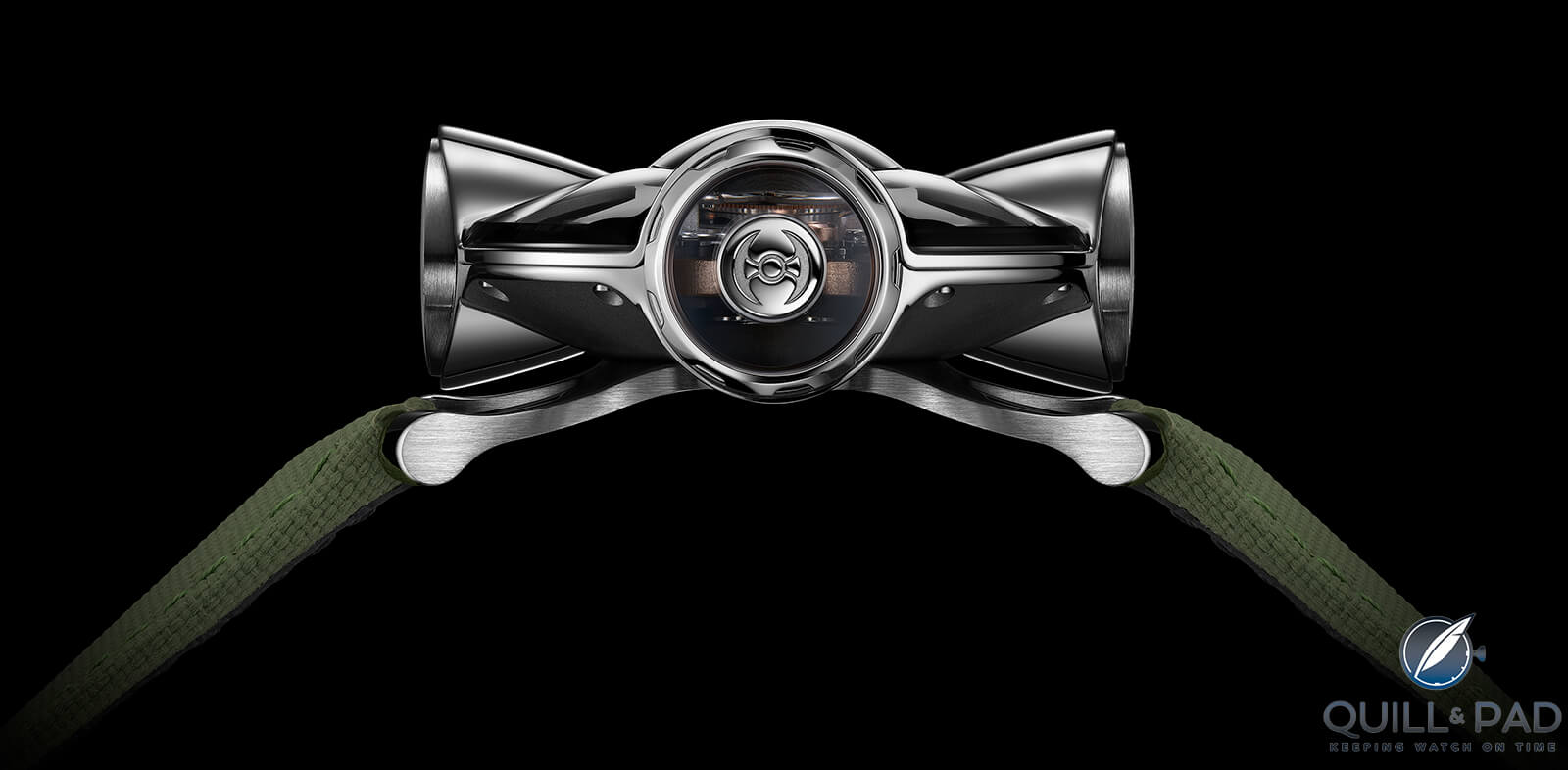
Transparent crown ‘window’ of the MB%F HM11
Firstly, since it is a room in a house, it needs a window, as a result the entire face of the crown is a large sapphire crystal to provide light and views into the movement.
The crown is a rather large 10 mm in diameter, meaning that to both maintain the view into the movement and protect the movement from dust and water, a set of 8 gaskets and very carefully designed crown “stem” needed to be created.
There are actually two sapphire windows, one mounted on the crown and one mounted into the case with a hole passing through. The typical battle axe design is in the center of the outer crown window to maintain the MB&F design language, and this is what rotates through the secondary window.
Given how complex the idea for a see-through crown is it is awesome that the team maintained the window into this room.
That’s hot
Continuing counterclockwise around the house, we come to the next room that houses a thermometer.
Obviously.

MB&F HM11 Architect with thermometer dial facing (photo courtesy Eric Rossier/MB&F)
But in all seriousness, a thermometer makes perfect sense in a home, and a similar amount of sense on a wrist-mounted machine that is a source of information. Using a typical coiled bimetallic strip, the thermometer will show a temperature range of -20 to 60° Celsius, or 0 to 140° Fahrenheit, the choice is up to the buyer.
The thermometer operates fully independently of the movement that occupies the other rooms and the main case, but aesthetically it matches the era and MB&F style.
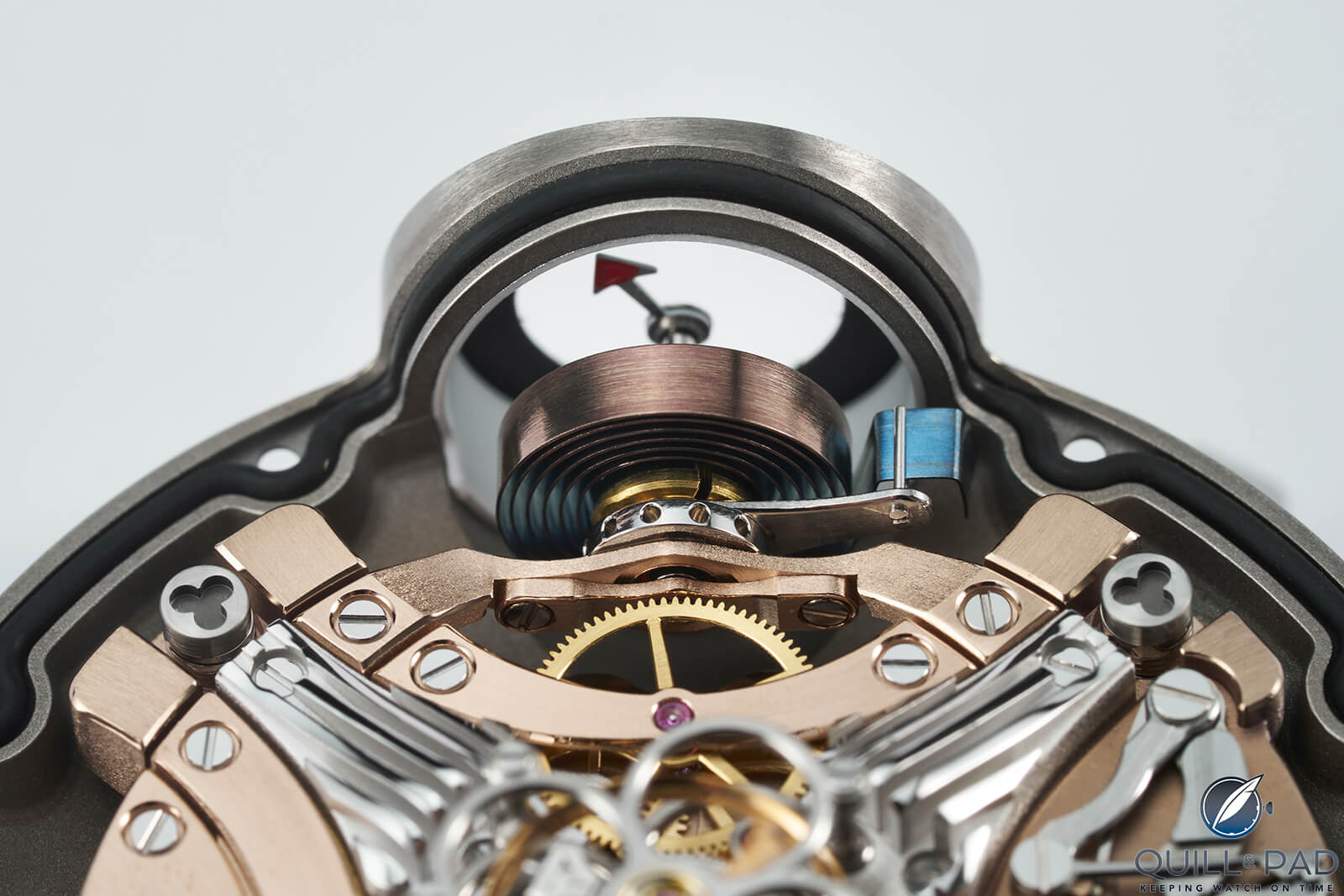
From the inside out view of the power reserve indicator of the MB&F HM11
The next room is where we find the power reserve display, artfully created using a very specific aesthetic, that of the Herman Miller Ball Clock. Using a range of decreasing in size polished spheres mounted on tiny rods, the power reserve shows the clear connection to atomic age design.
But if that wasn’t enough, the final room should seal the deal.
In the fourth room continuing counterclockwise around the HM11, we finally arrive at the time display, which shows the hours and minutes. Once again it is a faithful interpretation of the Herman Miller Ball Clock, this time in nearly the same form.
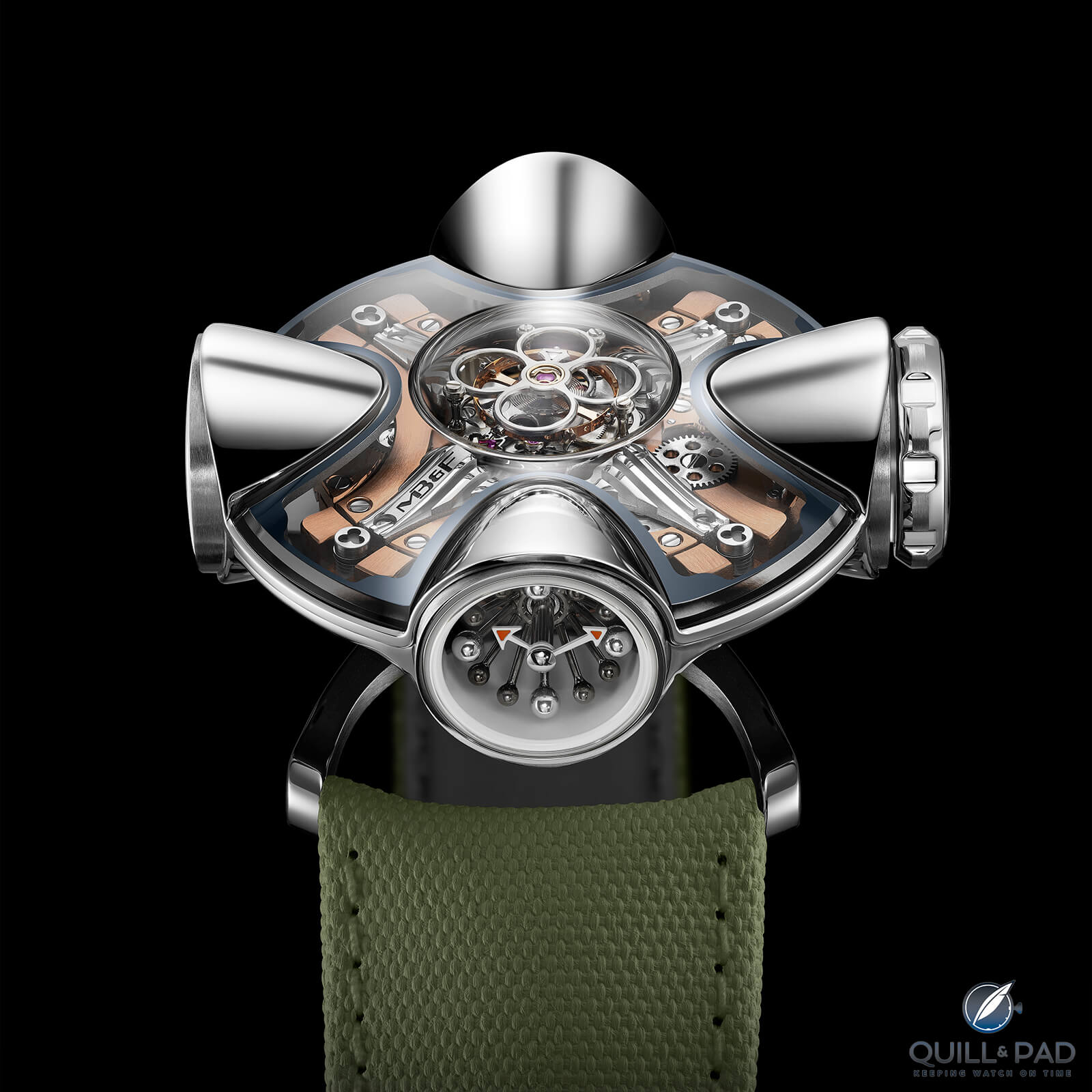
Hour and minute ‘room’ of the MB&F HM11 Architect
The largest difference is the use of larger spheres for 12, 3, 6, and 9 o’clock, while the remaining hours are a bit smaller and darkened just a bit. Otherwise, this could be considered the official MB&F ball clock, and this design choice is just – chef’s kiss* – perfect.
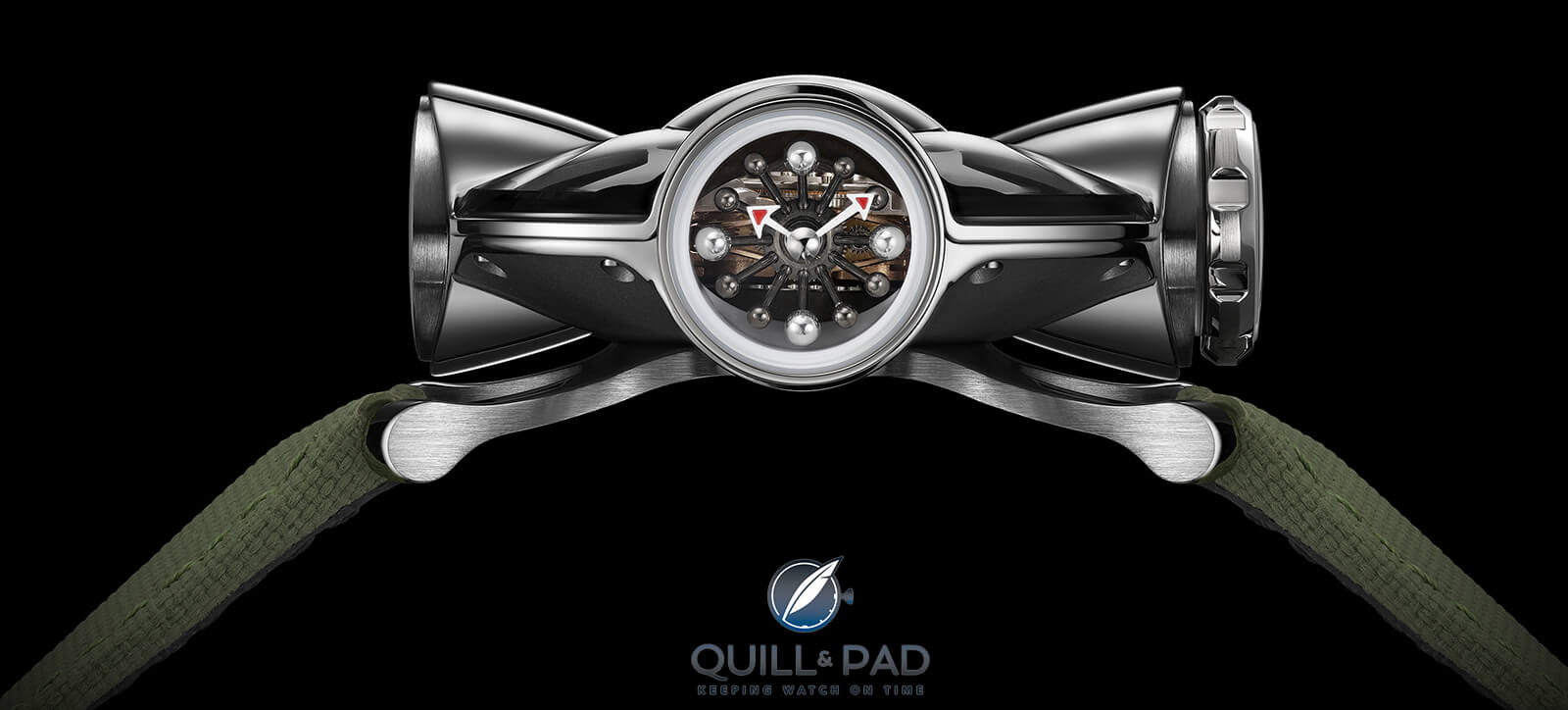
Hour and minute ‘room’ of the MB&F HM11 Architect
I can’t say that over the last couple decades I have agreed with every single design decision of the team, but this could not have been a better choice, it fully conveys the inspirational intent to nearly anyone that has seen the general space age aesthetic.
If you haven’t seen the original ball clock or any of its modern clones, and you haven’t ever seen the Atomium in Brussels (in person or in a photo), it is still extremely likely you have some experience with styles and designs that came from the space age/atomic design movements.
Spin me right round, baby, right round
These design choices are fairly difficult to construct at this scale, but the end result is worth it. Added on top of the aesthetics, the radial display of various information does require careful mechanical design as well, with bevel gears and horizontal shafts, though these are not actually new to MB&F.
This type of mechanism design can be seen in the HM4, HM6, and HM9, demonstrating the wide variety that can be accomplished using established practices.
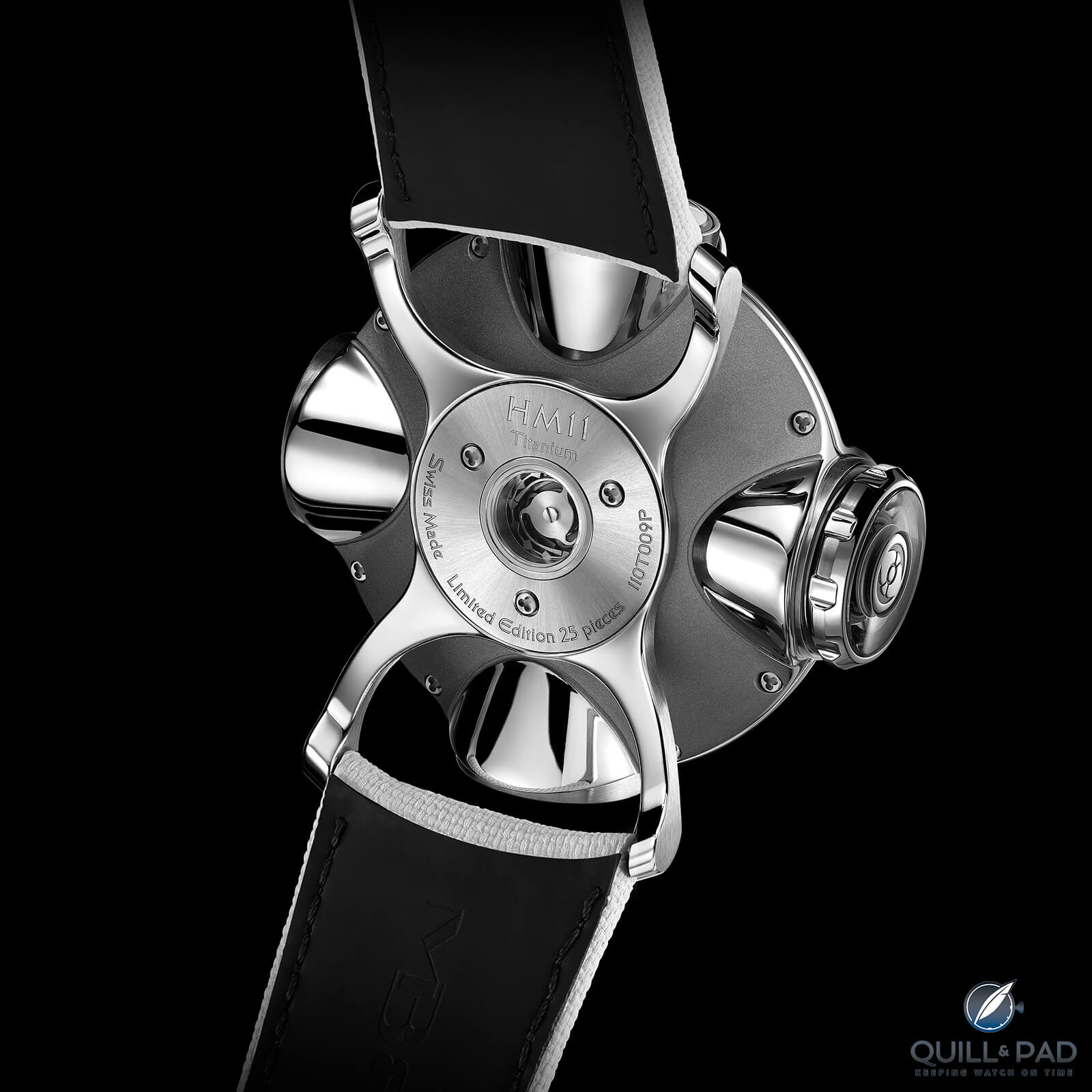
Lugs and back of the MB&F HM11 Architect with the central pivot point
But for now, we are done with the rooms, though not with the interesting design choices. As previously mentioned, for winding the entire case rotates on a central pivot where the case meets the lugs, or in this case the “landing frame.”
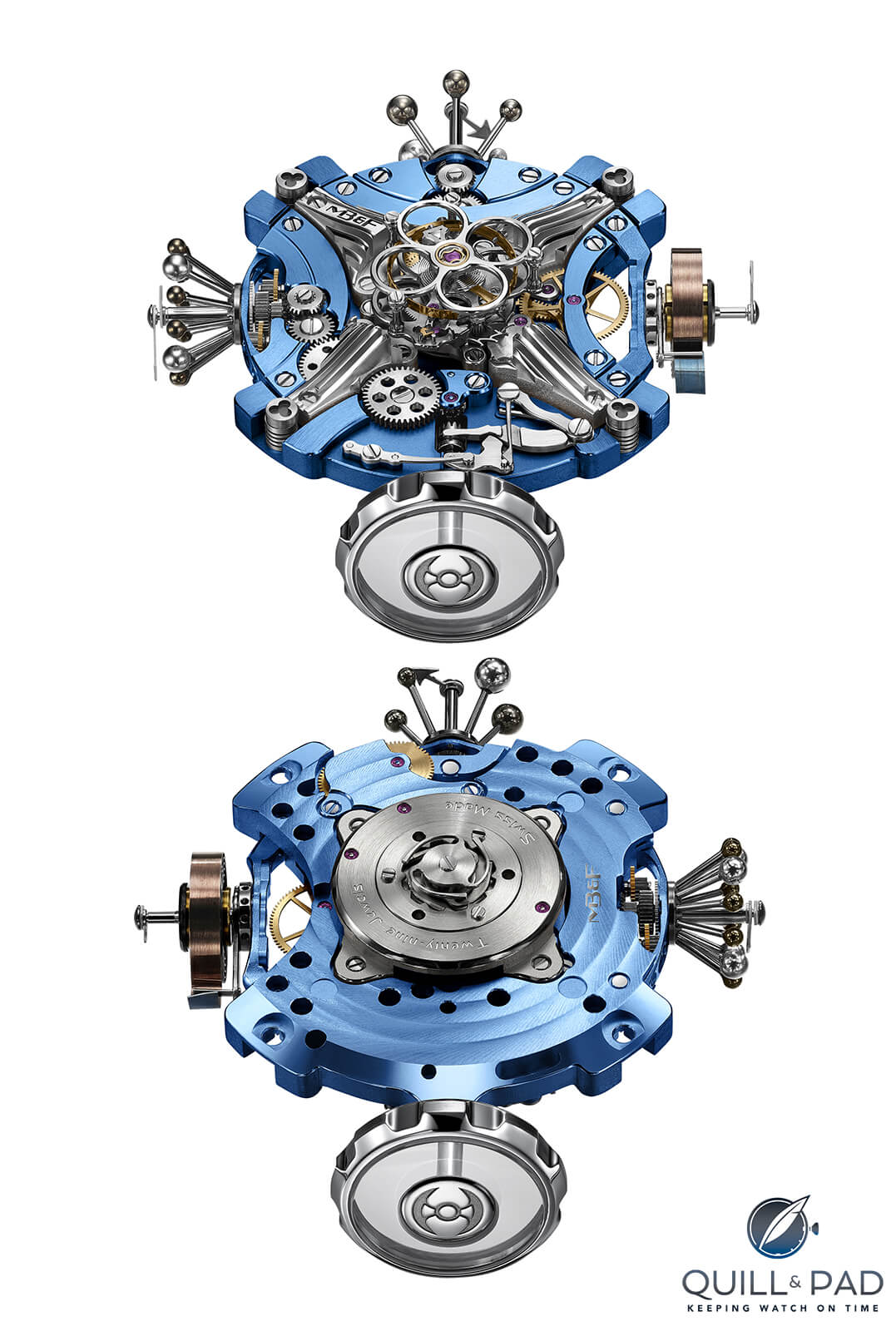
Movement of the MB&F HM11 Architect
You might think this could be accomplished similarly to a traditional crown since there is no need to show the inner workings, but you would be wrong. The frame uses a wide platform that is screwed to the winding mechanism, allowing the torque to be distributed across a larger surface, preventing any damage from an overzealous user.
In the center of this platform is another window, one we might imagine would be for the tractor beam pod bay, where you can see the ratchet mechanism that allows the case to click into position at 45° (or 1.5Ɠ to reference our new math symbol) increments.
There are also dual ratchet mechanisms stacked on top of each other to maintain the same 1.5Ɠ rotation in either direction, as clockwise rotation winds the mainspring.
An advantage of this configuration for the winding mechanism is the ability to upgrade the keyless works for more torque and a higher ratio, since it doesn’t need to fit in the thickness of a tiny case.
Due to this change you can wind the watch in 72-minute increments with each click, only requiring 10 full revolutions for the entire 96-hour power reserve.
Full package thinking
While that covers a majority of the unique mechanical features, it’s pretty easy to say that every MB&F caliber is wholly unique, and this one is no different… in being unique.
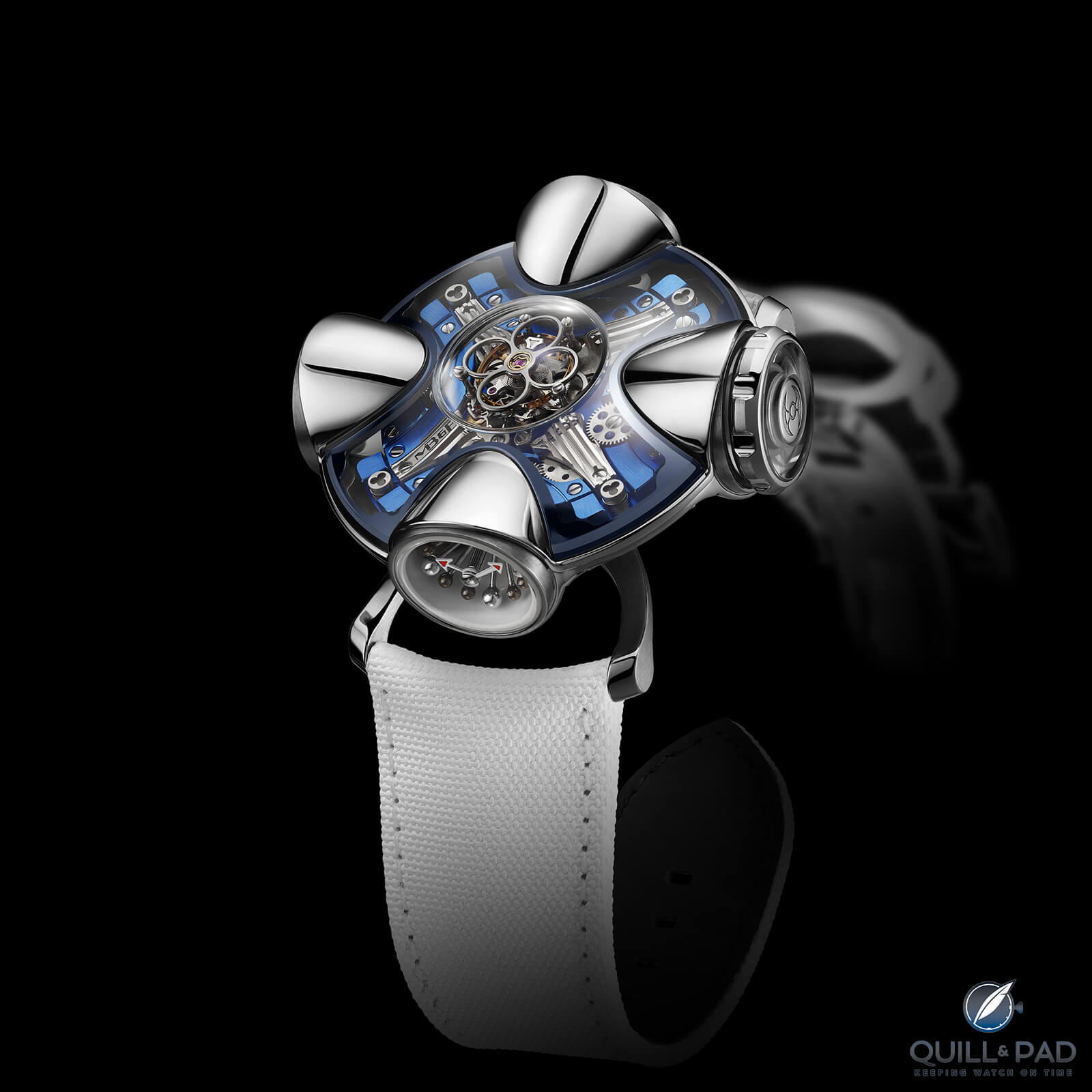
MB&F HM11 Architect
Built from scratch, the caliber is centered around a flying tourbillon on the top, with four arms extending outward in a cross, providing structure and aesthetic shape to the top of the main plate.
The functions are divided into quadrants to match the rooms and result in a very visually intriguing movement.
The case, a very complicated construction thanks to the design direction, is impressive even when partially assembled, a large, undulating rubber gasket snaking its way around the case back, and each room’s porthole window arch rising from the case as a single structure.
Such an assembly is not an easy thing to imagine when sitting down at the drawing board, but it’s clear that with a firm aesthetic direction some fantastic engineering is possible.
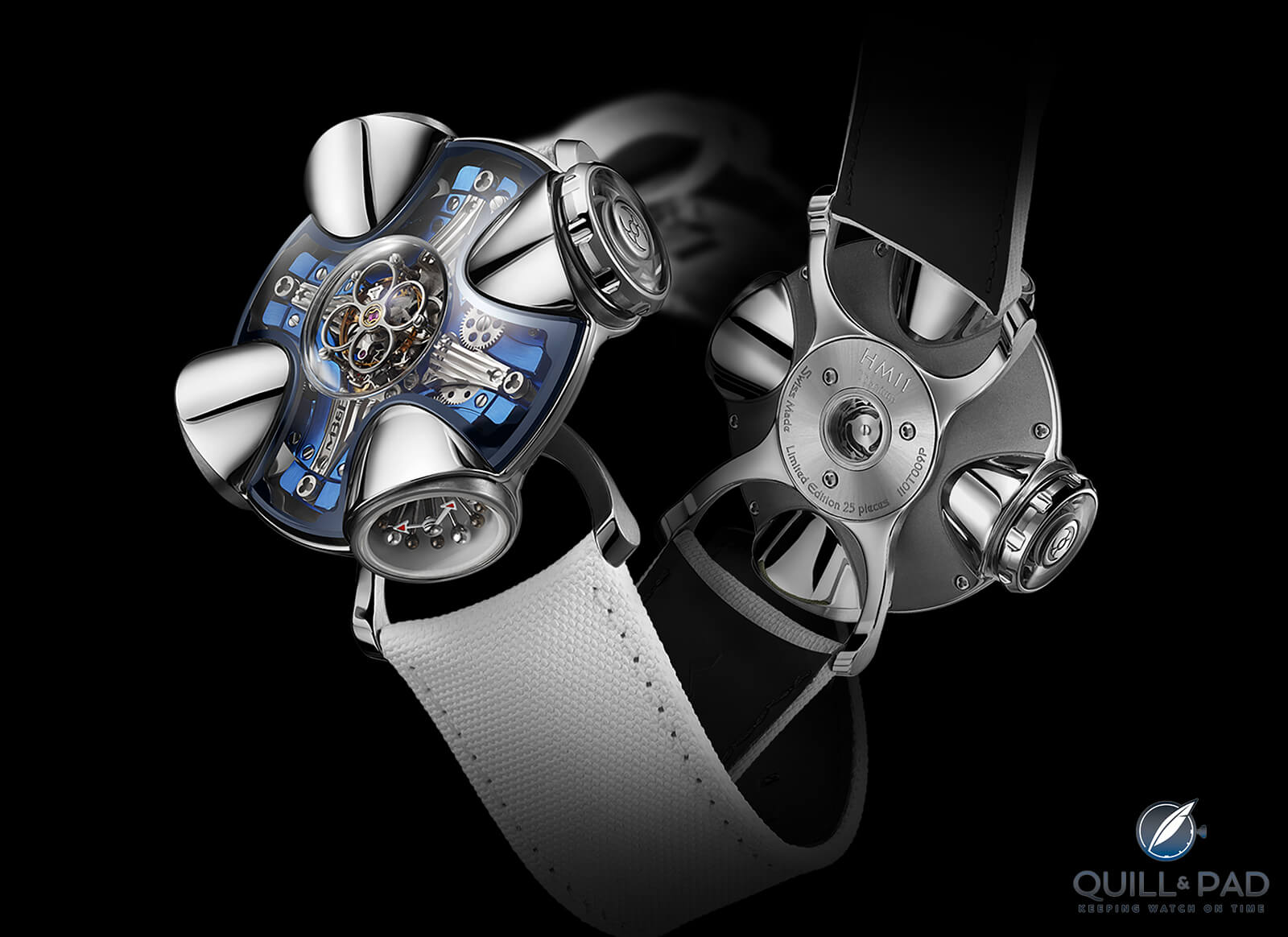
MB&F HM11 Architect front and back
The HM11 as a whole looks as if it could even be a scale model of an actual structure in the world, a rotating house sitting in some epic landscape or surrounded by the forest of some far away interstellar planet.
As a watch, it is right in line with what MB&F creates: watches that are pretty much out of this world every single time. Taking the concept of the HM11 as a scale model of a house, it could also be a scale model of a clock, maybe another collaboration with L’Epee.
If this was scaled up from 42 mm to 420 mm it would provide a whole new avenue for a collaborative time art piece, and a bigger form factor for more details or functionality.
HM11 might be the most perfectly suited to “clockification” in the entire history of MB&F’s watches. It’s just a thought, feel free to contact me for more amazing ideas Max.
In its current form though, it is still an incredible machine, seemingly designed just to be art, yet resulting in a stupendously cool functional object.
The consideration that clearly went into this piece, from the design through to the mechanics, even how to make sure the thermometer reads the room temperature and not body temperature (thank you, landing frame), showcases the continuing determination from those working with MB&F.
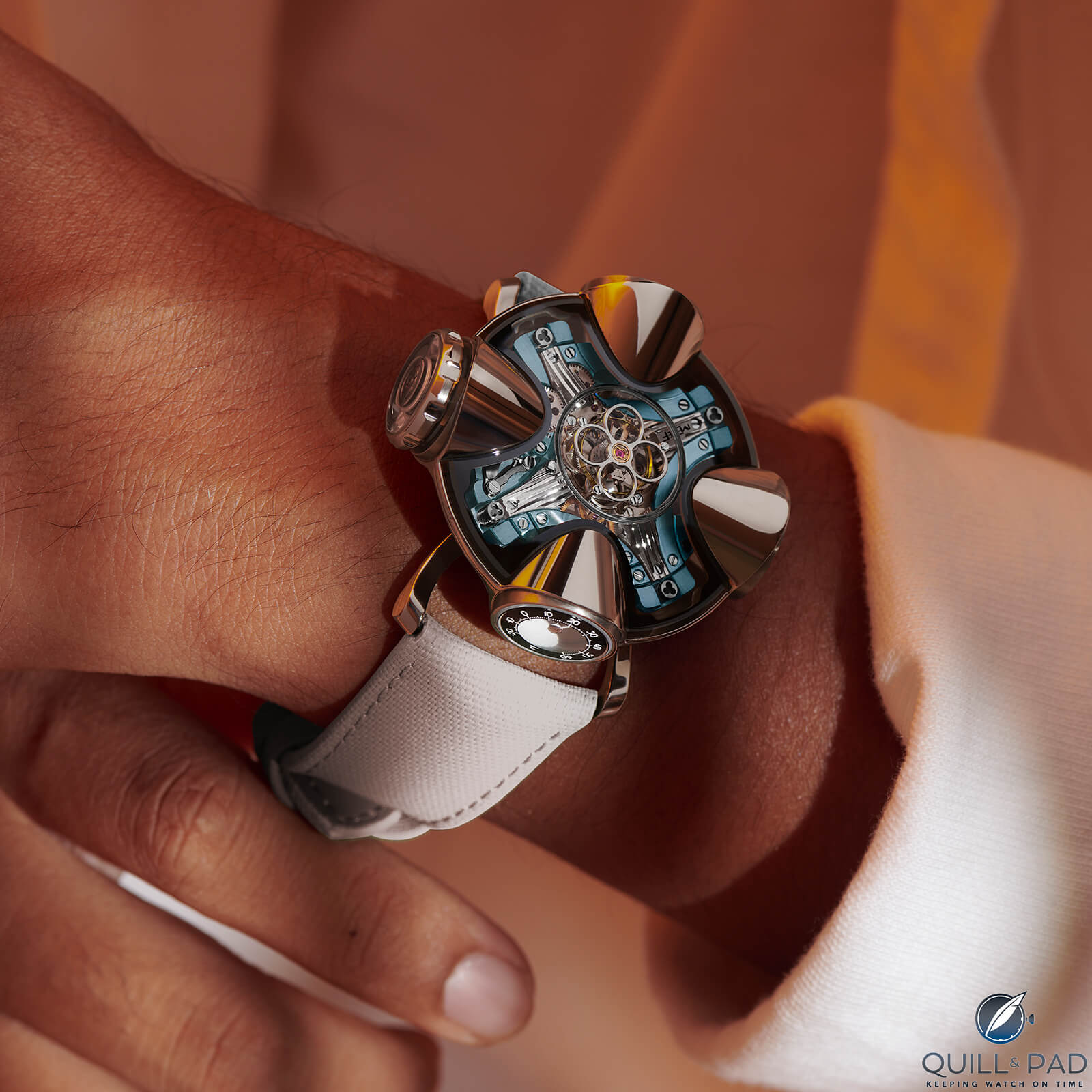
MB&F HM11 Architect on the wrist (photo courtesy Eric Rossier/MB&F)
There is no reason for a watch like this to exist other than exuberant passion, a “What if?” posed by someone who has never stopped to ask “Why?” The why is obvious, the why is visceral, the why doesn’t even need to be asked because it is understood by everyone on the team.
This is what makes the HM11 and MB&F as a whole such a successful creator of objects that inspire passion, because it’s passion all the way down.
So before the HM11 lifts off into space, let’s try to break this down!
- Wowza Factor *9.95 MB&F always has a high wowza factor, but creating a watch that could be a clock that could be a house is incredible, and garners a nearly perfect score for many, many wowza moments!
- Late Night Lust Appeal * 99.5 » 975.762m/s2 Just shy of 100 g’s of lust appeal, the HM11 has enough crooks and crannies of horological awesomeness to keep anyone exploring until the early morning!
- M.G.R. * 68.9 This is a massively geeky movement, mainly from how it’s shaped and constructed, and where the user interacts with it. Even though the functions are fairly typical, the execution is far from it!
- Added-Functionitis * Medium This is a watch that adds functions in a variety of ways, and functions that are practically useful, especially the thermometer and ability to rotate the case for viewing different rooms. I would strongly advise the use of extra-strength Gotta-HAVE-That cream to manage the space-age horological swelling!
- Ouch Outline * 13 Stepping on a LEGO! A rare perfect score in the ouch outline, because I would happily and merrily submit to a field of LEGO’s with bare feet for a chance to have the HM11 on my wrist!
- Mermaid Moment * The case rotates to view each room?! MB&F watches are not the traditional aesthetic that is easy to immediately love for many watch nerds, even though they are usually right up my alley. For this watch, it was already ranking high until I found out the rotating case was multi-functional, and that realization had me trying on tuxedos!
- Awesome Total * 912 For such an amazing piece we should begin with the number of components in the incredible case (92), then add the number of components in this awesome movement (364) then multiply by how many versions are in this groundbreaking launch (2) for a result that is as equally impressive as the watch itself!
For more information, please visit www.mbandf.com/en/machines/horological-machines/hm11.
Quick Facts MB&F HM11 Architect
Functions: Hours, minutes, power reserve, temperature, rotating display
Case: 42 x 23 mm, titanium
Movement: manually wound HM11 caliber, 96-hour power reserve, 18,000 vph/2.5Hz flying tourbillon
Limitation: 50 pieces, 25 in each red gold and blue dial versions
Price: CHF 214,000 (The blue edition has sold out)
You might also enjoy:
MB&F Legacy Machine Perpetual Reviewed by Tim Mosso
MB&F Legacy Machine Sequential Flyback Dual Chronograph
Behind The Lens: MB&F Horological Machine No. 9 Sapphire Vision In White Gold
Presenting ‘Making Time’: The Greatest Watch Film Ever Made (In My Extremely Biased Opinion)



Leave a Reply
Want to join the discussion?Feel free to contribute!